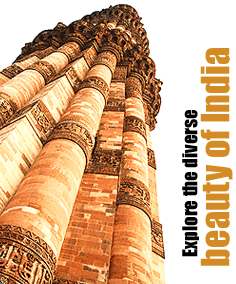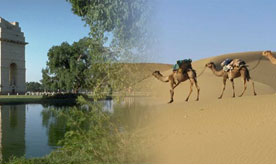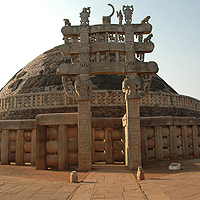|
 |
| Temples of India in styles varying from simple to most extravagant with detailed work of art reflect grandeur and spiritual character of its inhabitants.
|
|
|
| |
 |
|
|
|
 |
 |
|
Ajanta & Ellora
 The prosperous Indian State of Maharastra conserves yet another rich legacy of Buddhism in form of the AJANTA AND ELLORA CAVES. The caves are located in Aurangabad and exhibit a brilliant blend of human effort and beauty. They delightfully present the essence of the great ancient Indian architectural heritage.
The prosperous Indian State of Maharastra conserves yet another rich legacy of Buddhism in form of the AJANTA AND ELLORA CAVES. The caves are located in Aurangabad and exhibit a brilliant blend of human effort and beauty. They delightfully present the essence of the great ancient Indian architectural heritage.
These millennium old 34 caves at Ellora and the 29 caves at Ajanta came to fore somewhere in the early 18th century. Among the caves, the Ajanta group of caves in the Sahyadri hills give a picture of Buddhism that was once a part of Buddha from 200 BC to 650 AD. They were built to provide quiet and isolated place of stay for Buddhist monks.
The monks exploited the caves to teach learning of Buddhism besides regularly performing rituals in the Chaityas and Viharas. These were meant to enhance Buddhist cultural movement. The monks are credited for such impressive caves. Like Ajanta caves, the 34 Ellora caves hold immense significance for their delicately adorned interiors. They blend Hinduism, Buddhism and Jainism and draw devotees from all these faiths.
Ellora caves had been carved somewhere during 350 AD to 700 AD period. Out of the total caves, the 12 caves to the south belong to Buddhism and thus get devotes from all parts of the globe. Alongside exhibiting values and faith of different great Indian religions, the both Ajanta and Allora caves give an account into colossal wealth of Indian heritage.
Sanchi
Sanchi, a small village, in the state of Madhya Pradesh in India, is a world-famous site for its Buddhist link. Just about 70-90 minutes drive from the capital Bhopal, it attracts world’s attention for its numerous Buddhist monuments. These monuments of Buddhism had been carved from 3rd century to 12th century BC. More than few Buddhist stupas, monasteries, temples and pillars have transformed Sanchi into a global tourism centre. Buddhist link. Just about 70-90 minutes drive from the capital Bhopal, it attracts world’s attention for its numerous Buddhist monuments. These monuments of Buddhism had been carved from 3rd century to 12th century BC. More than few Buddhist stupas, monasteries, temples and pillars have transformed Sanchi into a global tourism centre.
The stupas depict the life of Lord Buddha as they were built by a great emperor Ashoka. Ashoka the Great was a great follower of Buddhism and liked the Lord Buddha for his teachings, preaching and profound knowledge of human and its miseries. The site is now a UNESCO World Heritage Sites for its global potential.
Sanchi’s biggest attraction is the main stupa which is quite old, may be among the oldest existing structures in India. The Stupas at Sanchi do not comprise any images of Lord Buddha in human form, though they metaphorically describe the Lord Buddha through figures. All the information of the life of the Buddha comes into fore through these stupas.
|
|
|

